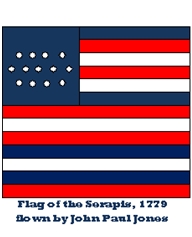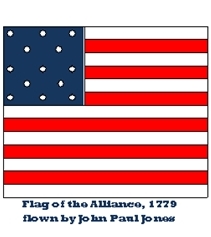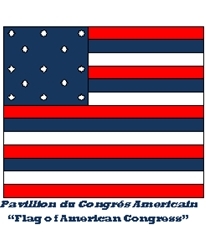Three Cheers for the Red, White & Blue!
On June 14th in 1777 the Second Continental Congress passed a resolution proposed by the Marine Committee: “Resolved: that the flag of the United States be made of thirteen stripes, alternate red and white; that the union be thirteen stars, white on a blue field, representing a new constellation.”
On first glance, the description seems sufficient. Knowing, as we do, what the first U.S. flag looked like, we mentally check off the items: thirteen red and white stripes, check; a union, check; thirteen white stars on blue, check. Yes, everything is there. On the other hand, there are many details not clearly defined in that resolution. Is it seven red stripes or only six? How big is the union? How many points does each star have? What is the pattern for the stars? A circle of thirteen? Twelve stars in a circle surrounding a central star? Or are the stars displayed in rows? How many rows? Is the flag square or rectangular? If we had never seen an American flag, we would have a lot of questions that the Flag Resolution did not answer. Many variants are possible all following the description in the flag resolution.
Strangely, the flags actually used during the American Revolution were even more diverse than that. It was not uncommon for early U.S. flags to boast red, white and . . . blue stripes. As a matter of fact, Benjamin Franklin and John Adams, our commissioners to France, described the flag in 1778 as follows: “It is with pleasure that we acquaint your Excellency that the flag of the United States of America consists of 13 stripes, alternately red, white and blue; a small square in the upper angle, next to the flag staff, is a blue field, with 13 white stars, denoting a new Constellation.”
Some illustrations of the period show U.S. flags with red white and blue stripes. John Paul Jones sailed into the Dutch harbor at Texel in 1779 with two ships. One was an American vessel, the Alliance. The second was a British ship that Jones had captured. The British protested to Dutch authorities that the ships did not fly recognized national ensigns; therefore, Jones and his crews were pirates. Quietly, the Dutch sent an artist down to the wharf with instructions to paint illustrations of the flags flying from the two American ships. They then placed the pictures in their files. When the British complained again, the Dutch pulled out the paintings of the two flags. The Dutch did recognize the flags as genuine national flags. A few years later, in 1793, a sheet of national flags was published in Augsberg, Germany. It showed the U.S. flag labeled in French “Pavillion du Congrés Americain,” which translates “Flag of American Congress.” It also shows red, white and blue stripes.

 This points out that there were actually many variations of the Stars and Stripes in the early years of the republic. Details were pretty much left up to the flag maker. If it had stars, stripes and was red white and blue, that was close enough. Today, all of these questions have been answered. The description for the United States flag is extremely specific in every detail. Even the ratios of each dimension are spelled out. If the hoist (width) is given the ratio value of 1.0, then the fly (length) is 1.9. Even the ratio of the stars has been computed. Each of the fifty stars is officially designated as being a ratio of 0.0616 of the hoist. Click for the chart here.
This points out that there were actually many variations of the Stars and Stripes in the early years of the republic. Details were pretty much left up to the flag maker. If it had stars, stripes and was red white and blue, that was close enough. Today, all of these questions have been answered. The description for the United States flag is extremely specific in every detail. Even the ratios of each dimension are spelled out. If the hoist (width) is given the ratio value of 1.0, then the fly (length) is 1.9. Even the ratio of the stars has been computed. Each of the fifty stars is officially designated as being a ratio of 0.0616 of the hoist. Click for the chart here.
Also, learn more here…
If you want to make a flag, better get out your scientific calculator. Better yet, buy a ready made flag. Colonial Flag will make sure you get a flag that is correct. Three cheers for the red white and blue!

I always fly our flag all sumemr long. It goes up Memorial day and comes down Labor day. I dont follow all the rules, so dont tell anyone. I love coming home and seeing the flag blowing in the breeze (the hot oven breeze ;)Happy 4th! ~Rosanne